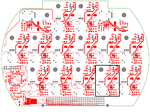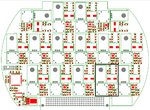mertkan65
Junior Member level 3
- Joined
- Nov 24, 2004
- Messages
- 30
- Helped
- 0
- Reputation
- 0
- Reaction score
- 0
- Trophy points
- 1,286
- Location
- Ankara/Turkey
- Activity points
- 279
Dear All,
We have 15 channel class AB type amplifier on single PCB. All these channels generated with same schematic with top sheet and room layout. 14 Channel works fine with calculated gain but 1 channel has a low gain according to others. We have try many things but we could not identify problem. Except Input and output of the channels, all the remaining traces are the same, we have exluce traces and made it through directly input components and very short cable with output but nothing changed. Do you have any idea for the layout problem? Please find schematic and signal at requested gain (bad signal) as attached.
We have 15 channel class AB type amplifier on single PCB. All these channels generated with same schematic with top sheet and room layout. 14 Channel works fine with calculated gain but 1 channel has a low gain according to others. We have try many things but we could not identify problem. Except Input and output of the channels, all the remaining traces are the same, we have exluce traces and made it through directly input components and very short cable with output but nothing changed. Do you have any idea for the layout problem? Please find schematic and signal at requested gain (bad signal) as attached.




